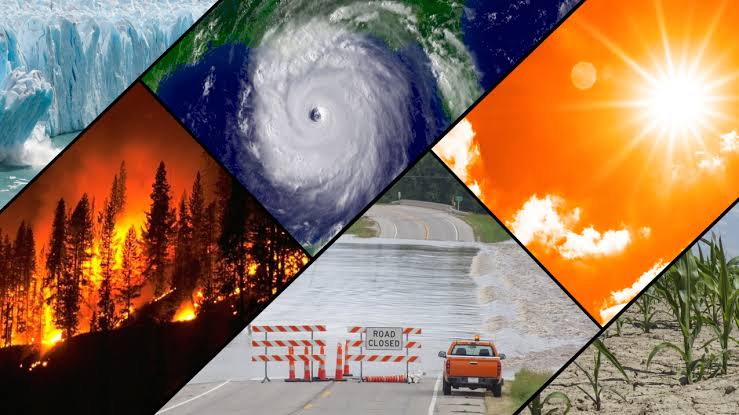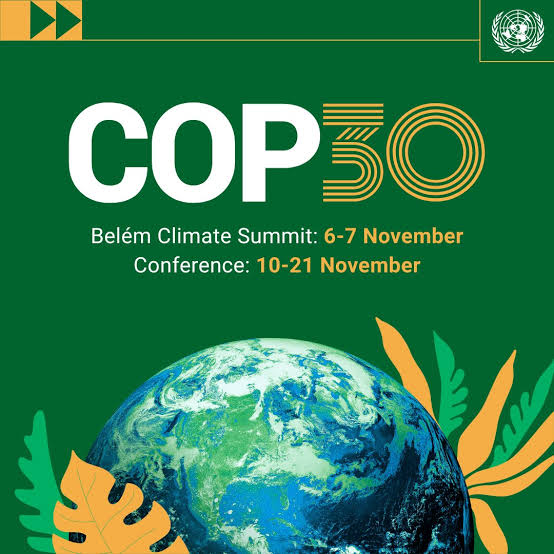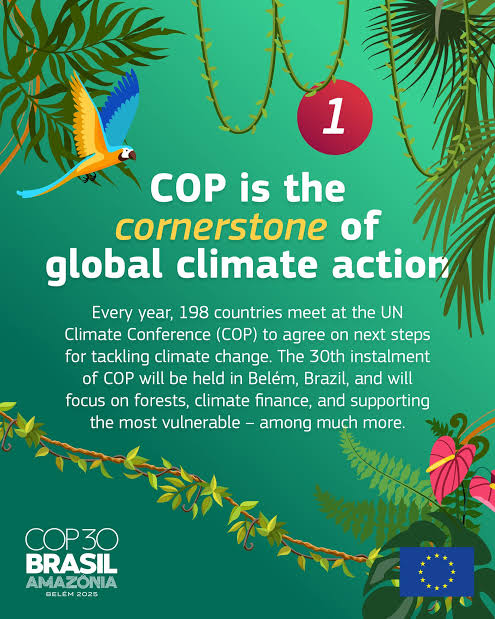Climate Change & COP30: Why It Matters for Pakistan

Introduction
The 30th Conference of the Parties (COP30) is currently underway in Belém, Brazil, bringing together global leaders, climate experts, and vulnerable nations to push for stronger action against the climate crisis.
For Pakistan. One of the most climate‑vulnerable countries
COP30 is more than just a diplomatic event: it’s a critical moment. The decisions made here can shape Pakistan’s climate resilience, funding, and future.

Key Developments at COP30 That Impact Pakistan
1. Pakistan’s Climate Prosperity Plan (CPP)
- At COP30, Pakistan is showcasing its Climate Prosperity Plan, created under the Climate Vulnerable Forum (CVF).
- The plan aims to build a climate-resilient, low-carbon, and inclusive economy.
- Pakistan is pushing for stronger cooperation, green investment, and international support through this plan.
This reflects the country’s commitment to contribute constructively at the global climate forum.
2. COP30 Recognition for Punjab’s Leadership
- Punjab Chief Minister Maryam Nawaz met with the World Bank’s Climate Change Group Director during COP30.
- The World Bank praised her as a “Climate Change Warrior” and offered support for green projects in Punjab, including clean energy, wildlife, transport, and forestry.
- Punjab is seeking to join the Global Carbon Market, which could bring new funding and investments.
3. Pre-COP30 Dialogue on Climate Justice
- The Pakistan Red Crescent Society held a national dialogue ahead of COP30, calling for climate justice and more support for vulnerable communities.
- Lawmakers, climate experts, and youth participated, highlighting how severely climate change is hurting Pakistan.
- The event emphasized that despite contributing very little to global emissions, Pakistan is facing huge climate risks.
4. Push for Better Funding & International Support
- Pakistan has reiterated its demand for grant-based climate finance, not just loans, especially for adaptation and loss & damage.
- At COP30, the country is asking for more technology transfer, stronger institutions, and technical capacity building.
- This is closely tied to its Nationally Determined Contributions (NDC 3.0).

How Climate Change Is Already Hitting Pakistan
COP30’s debates aren’t just theoretical for Pakistan — the impact of climate change is deeply felt across the country.
Here’s how:
1. Livelihoods Under Threat
According to Pakistan’s Finance Minister, climate change is already affecting food production and the livelihoods of millions. Erratic rainfall, flash floods, and drought are putting farmers and rural communities under great stress.
2. Glacier Melt and Flash Floods
Glacier melt in mountainous regions of Pakistan has accelerated due to rising global temperatures, threatening water security and local ecosystems. This rapid melting contributes to the formation of glacial lakes, which can suddenly burst and cause devastating flash floods downstream. Communities in northern Pakistan, particularly in Gilgit-Baltistan and Khyber Pakhtunkhwa, are most vulnerable to these hazards.

Early warning systems and climate adaptation strategies are critical to reducing loss of life and property. Scientists warn that without urgent climate action, these events will become more frequent and severe.
Internal Links: Climate Change in Pakistan, Pakistan Flood Management
External Links: IPCC Report on Glaciers, Amnesty International: Climate Risks
3. Economic Loss & Damage
Pakistan has over 7,000 glaciers in its northern regions, many of which are melting rapidly. This melting is causing glacial lake outburst floods (GLOFs) — a major risk for mountainous areas.
In 2025, unusually high temperatures in Gilgit-Baltistan (up to 48.5 °C) have made things worse. The result: deadly floods, landslides, destruction of homes, and risk to water supply.
4. Stress on Water Systems
According to The Diplomat, Pakistan lost around US$ 30 billion due to extreme weather, as per the Climate Risk Index.
5. The Amnesty International
Report notes Pakistan needs around USD 16 billion to recover from losses and damages — but most of its funding comes as loans. These financial burdens limit the country’s ability to build resilience. As glaciers shrink, water availability for the Indus River Basin could drop significantly.
Groundwater levels are also falling rapidly, especially in Punjab, where aquifers are over-exploited. Coastal communities (e.g., in Sindh) are also threatened by salinity intrusion due to rising sea levels.
5. Social Vulnerabilities
Experts warn that children and older people are disproportionately affected by climate disasters. In 2024, Pakistan tied its climate policies to young people’s needs by signing a Youth & Climate Action Declaration at COP29, preparing for stronger youth-centered policies in NDC 3.0. Institutions are weak, and there is limited technical capacity, making implementation of climate projects difficult.

Why COP30 Is a Turning Point for Pakistan
Negotiating Power: As a vulnerable nation, Pakistan is using COP30 to demand fair treatment, more grants, and technology transfer.
Global Platform: By presenting its Climate Prosperity Plan, Pakistan is pushing for South-South cooperation and green investments. Visibility: With Pakistani leaders (like Punjab’s CM) gaining recognition, the country’s climate issues are being heard on a global stage. Implementation: The decisions at COP30 could lead to real actions — not just promises — on building early-warning systems, strengthening disaster management, and protecting communities.
Challenges & Risks for Pakistan at COP30
Finance Gap: Even with plans, Pakistan may not get sufficient grant-based finance; loans are not enough.
Technical Capacity: Limited institutional capacity could slow down implementation of adaptation and resilience projects.
Debt Risk: With climate losses, the country risks increasing debt if climate finance is not designed wisely.
Climate Justice: Pakistan’s burden is heavy — despite low emissions, it suffers disproportionately.
Accountability: Ensuring that global climate funds are actually delivered and used properly is a major concern.

What Pakistan Must Do Now
- Push for loss & damage funding at COP30, especially grant-based.
- Strengthen its National Adaptation Plan (NAP) and NDC 3.0.
- Invest more in community-based early-warning systems for floods, heat, and GLOFs.
- Build green infrastructure, like clean energy projects, sustainable transport, and reforestation.
- Mobilize youth and civil society: children and young people are already taking action, and their voices should be central.
- Work with international partners (like the World Bank) to access carbon markets, green finance, and technology.
Conclusion
COP30 is a high-stakes moment for Pakistan.
The climate crisis is not a far-off threat — it’s already devastating the country. Through its Climate Prosperity Plan and strong diplomatic engagement, Pakistan is trying to seize the moment and demand justice, finance, and real climate action.
But success will depend on whether the promises made in Belém turn into concrete support and long-term resilience for millions of Pakistanis who are on the frontlines of the climate crisis.
Internal Links
- Climate Change in Pakistan: Impacts and Adaptation
- Pakistan Floods and Extreme Weather Events
- COP30: Pakistan’s Climate Commitments
- Loss & Damage Fund Operationalization in Pakistan
- Glacier Monitoring Policies in Pakistan
- South Asian Climate Research Initiatives
- Pakistan Climate Resilience Programs
- Extreme Weather Events Reports in Pakistan
- Adaptation Strategies for Melting Glaciers
- Pakistan Climate Risk Assessment
External links
- Pakistan Burns At 50°C: Can It Turn The Heat Down On Climate Change? | Insight, CNA Insider, via Youtube, 2 August 2022. (Award-winning documentary)
- Asian Developmental Bank Report on the Climate Change Profile of Pakistan
- Climate change in the Northwest Frontier Province of Pakistan
- Impact of climate change in Pakistan
- IPCC Report on Climate Change 2022: Impacts, Adaptation, and Vulnerability. Chapter 10: Asia
- “Global Warming impacts & Effects on The Climate of Pakistan” PakWeather.com 28 February 2015
- Business Recorder: New policy framework to monitor melting glaciers
- Al Jazeera: Behind Pakistan’s repeated floods: Melting glaciers
- Amnesty International: Climate change’s unequal impacts in Pakistan
- Ministry of Climate Change Pakistan: Glacier Research & Adaptation
- United Nations: Loss & Damage Fund Overview

Post Comment